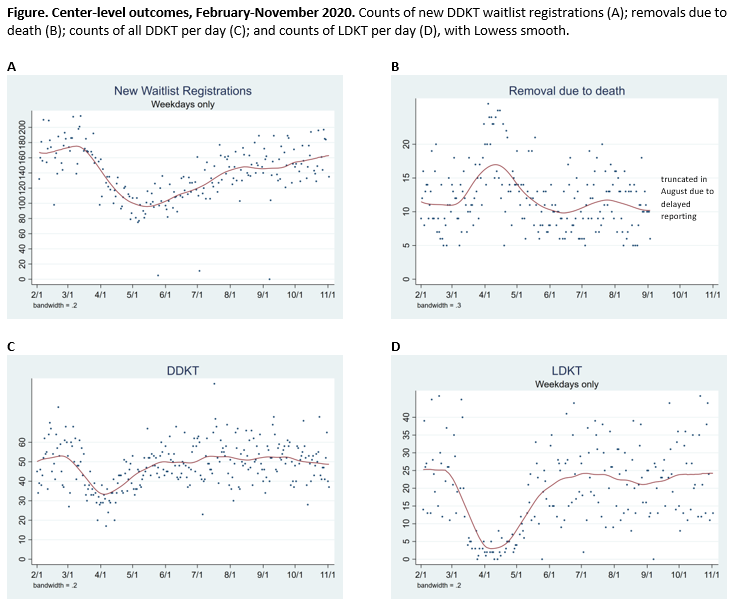Response to a Pandemic: The Fall and Rise of Kidney Transplantation in the US
1JHU, Baltimore, MD, 2SRTR, Minneapolis, MN
Meeting: 2021 American Transplant Congress
Abstract number: 426
Keywords: Donation, Kidney transplantation, Outcome, Waiting lists
Topic: Clinical Science » Kidney » Kidney Deceased Donor Allocation
Session Information
Session Name: Kidney Deceased Donor Allocation 2
Session Type: Poster Video Chat
Date: Sunday, June 6, 2021
Session Time: 7:30pm-8:30pm
 Presentation Time: 8:10pm-8:20pm
Presentation Time: 8:10pm-8:20pm
Location: Virtual
*Purpose: During the first wave of the COVID-19 epidemic in March-April 2020, waitlist registrations and living/deceased donor kidney transplants (LDKT/DDKT) dropped substantially. A second wave of infection peaked in August; a third wave began in late October and has not yet peaked. The effects on kidney transplantation in the US during the most recent waves have not yet been described.
*Methods: Using SRTR data, we compared observed waitlist registrations, waitlist mortality, LDKT, and DDKT 3/15/2020-10/31/2020 to expected events based on calculations from pre-epidemic data 1/2016-2/2020, overall and stratifying by state-level COVID-19 incidence, while accounting for patient casemix.
*Results: New listings bottomed at 45% below expected in May (IRR = 0.520.550.57) but steadily recovered to 6% below expected by October (IRR = 0.910.940.97) (Table, Figure). Waitlist deaths peaked at 72% above expected in March/April (IRR = 1.601.721.85), bottomed at 7% above expected in June (IRR = 0.961.071.20), and have since risen only slightly to 16% above expected in August (IRR = 1.041.161.29); July/August waitlist mortality increases were restricted to states with the highest COVID-19 burden (August IRR = 1.051.191.36). DDKT was below expected through June in states with the highest COVID-19 burden (IRR = 0.640.800.99). Nationwide, DDKT peaked in July at 11% above expected (IRR = 1.061.111.17) and have since dropped only slightly to 5% above expected by October (IRR = 0.991.051.10). LDKT bottomed at 87% below expected in March/April (IRR = 0.100.130.15), peaked at 10% below expected in July (IRR = 0.820.900.98), before the second wave peaked, and then dropped slightly to 14% below expected during September and October (IRR = 0.790.860.94).
*Conclusions: Each successive wave had a lesser impact on transplant and waitlist mortality rates. New listings have approached pre-pandemic rates, suggesting that the medical system has successfully adapted to the challenges of COVID-19, despite occasionally high patient load caused by additional epidemic waves. Decreased mortality may reflect improved care, but may also indicate that true COVID-19 incidence during the first wave was substantially higher than detected.
To cite this abstract in AMA style:
Bisen S, Boyarsky B, Werbel W, Snyder J, Garonzik-Wang J, Segev D, Massie A. Response to a Pandemic: The Fall and Rise of Kidney Transplantation in the US [abstract]. Am J Transplant. 2021; 21 (suppl 3). https://atcmeetingabstracts.com/abstract/response-to-a-pandemic-the-fall-and-rise-of-kidney-transplantation-in-the-us/. Accessed January 5, 2026.« Back to 2021 American Transplant Congress


